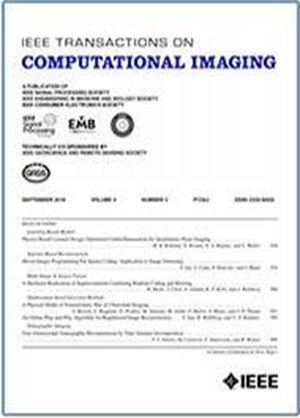分辨率分析中傅里叶环相关的新界
IF 4.8
2区 计算机科学
Q2 ENGINEERING, ELECTRICAL & ELECTRONIC
引用次数: 0
摘要
这项工作提出了一种新的数据驱动方法,用于使用成熟的傅立叶环/壳相关(frc/fsc)技术计算给定图像的分辨率数。提出的方法消除了用户以启发式方式选择阈值标准的需要,这是当前方法的要求。为了实现这一目标,该方法利用了线性代数(特别是Niculescu的结果)和信息论的概念,证明了分辨率数与傅立叶域中每个环或壳的Fisher信息直接相关。因此,该方法完全是数据驱动的,不需要分析图像的先验信息。通过数值实验和x射线相干显微镜、断层扫描、冷冻电镜和共聚焦显微镜的实际数据测试,验证了数学框架的一致性,表明新计算的分辨率数字与来自经典$1/2$-bit和$3\sigma$阈值的传统指标一致。此外,我们强调图像的局部分辨率与通常由frc/fsc提供的单一分辨率值有很大不同。这一观察结果表明,分辨率图可以提供一个更可靠的框架,以评估显微镜分辨率。本文章由计算机程序翻译,如有差异,请以英文原文为准。
A Novel Bound for Fourier Ring Correlation in Resolution Analysis
This work proposes a novel data-driven approach for computing the resolution number of a given image using the well-established Fourier Ring/Shell Correlation (frc/fsc) technique. The proposed method eliminates the need for the user to select a threshold criterion in a heuristic way, a requirement in current methodologies. To achieve this, the approach leverages linear algebra—specifically, Niculescu’s result—and concepts from information theory, demonstrating that the resolution number is directly linked to the Fisher information derived from each ring or shell in the Fourier domain. As a result, the methodology is entirely data-driven, requiring no prior information about the image under analysis. The mathematical framework’s consistency is validated through numerical experiments and tests with real data from x-ray coherent microscopy, tomography, cryo-EM and confocal microscopy, showing that the newly computed resolution numbers align with conventional metrics derived from the classical $1/2$ $3\sigma$ frc/fsc. This observation suggests that resolution maps may provide a more reliable framework for assessing resolution in microscopy.
求助全文
通过发布文献求助,成功后即可免费获取论文全文。
去求助
来源期刊

IEEE Transactions on Computational Imaging
Mathematics-Computational Mathematics
CiteScore
8.20
自引率
7.40%
发文量
59
期刊介绍:
The IEEE Transactions on Computational Imaging will publish articles where computation plays an integral role in the image formation process. Papers will cover all areas of computational imaging ranging from fundamental theoretical methods to the latest innovative computational imaging system designs. Topics of interest will include advanced algorithms and mathematical techniques, model-based data inversion, methods for image and signal recovery from sparse and incomplete data, techniques for non-traditional sensing of image data, methods for dynamic information acquisition and extraction from imaging sensors, software and hardware for efficient computation in imaging systems, and highly novel imaging system design.
 求助内容:
求助内容: 应助结果提醒方式:
应助结果提醒方式:


